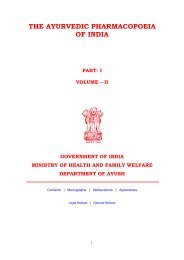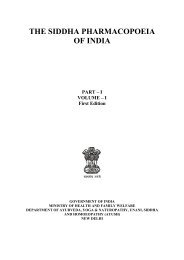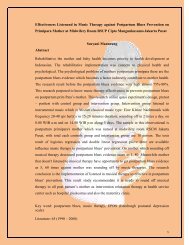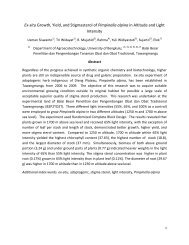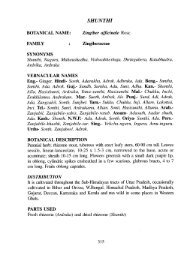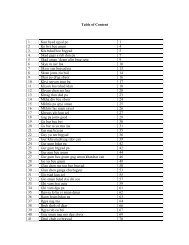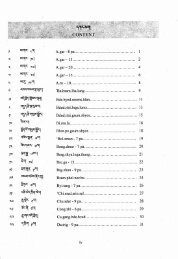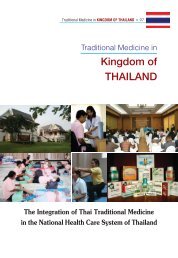Notes on the genus Kaempferia L. (Zingiberaceae) in Thailand
Notes on the genus Kaempferia L. (Zingiberaceae) in Thailand
Notes on the genus Kaempferia L. (Zingiberaceae) in Thailand
Create successful ePaper yourself
Turn your PDF publications into a flip-book with our unique Google optimized e-Paper software.
¯Ú<br />
«“√ “√°“√·æ∑¬å·ºπ‰∑¬·≈–°“√·æ∑¬å∑“߇≈◊Õ° ªï∑’ Ë ˆ©∫—∫∑’ Ë Ò ¡°√“§¡ - ‡¡…“¬π ÚııÒ<br />
Type: <strong>Thailand</strong>, Curtis 3252 (lectotype K)<br />
This tax<strong>on</strong> is placed am<strong>on</strong>g <strong>the</strong> K. galanga group,<br />
plants with 2-3 flat, near-<strong>the</strong>-ground leaves and <strong>in</strong>florescences<br />
produced <strong>in</strong> <strong>the</strong> <strong>in</strong>nermost leaf-sheaths.<br />
However, K. glauca Ridl. can be differentiated from<br />
o<strong>the</strong>r species of <strong>the</strong> same group by its glacous leaves,<br />
<strong>in</strong>florescence with hairy peduncle and violet flowers,<br />
obovate-cuneate to suborbicular lateral stam<strong>in</strong>odes,<br />
suborbicular labellum (divided to <strong>the</strong> base) with white<br />
blotch near <strong>the</strong> base, large violet recurved reniform<br />
an<strong>the</strong>r crest, and <strong>the</strong> hairy calyx tube and ovary.<br />
This species is distributed <strong>in</strong> <strong>Thailand</strong> and Laos.<br />
9. K. laotica Gagnep. <strong>in</strong> Bull. Soc. Bot Fr. 54: 166.<br />
1907; Gagnep. <strong>in</strong> Lecomte, Fl. Gén. I.-C. 6: 51. 1908;<br />
Sirirugsa <strong>in</strong> Nord. J. Bot. 9: 259. 1989 & <strong>in</strong> Thai For.<br />
Bull. (Bot.) 19: 14. 1992.<br />
Type: Laos, Xiang-kouang, Spire 309 (holotype P)<br />
This tax<strong>on</strong> is also <strong>in</strong> <strong>the</strong> K. galanga group, plants<br />
usually with two flat, near-<strong>the</strong>-ground leaves and <strong>in</strong>florescences<br />
produced <strong>in</strong> <strong>the</strong> <strong>in</strong>nermost leaf-sheaths.<br />
It differs from K. elegans Wall. ex Baker and K. glauca<br />
Ridl. by its sessile <strong>in</strong>florescences and glabrous calyx<br />
tubes and ovaries. However, it is similar to K.<br />
roscoeana Wall., but differs <strong>in</strong> <strong>the</strong> follow<strong>in</strong>g characters:<br />
<strong>the</strong> lower leaf surface is hairy and <strong>the</strong> an<strong>the</strong>r<br />
crest rectangular with <strong>the</strong> entire or emarg<strong>in</strong>ate apex<br />
(compared with <strong>the</strong> leaves, both sides are glabrous<br />
and <strong>the</strong> an<strong>the</strong>r crest is small, ovate keeled with <strong>the</strong><br />
entire apex). The flower of this species is white with<br />
obovate-cuneate stam<strong>in</strong>odes and deeply divided obovate<br />
lips with purple blotch at <strong>the</strong> center.<br />
This species is distributed <strong>in</strong> evergreen forests<br />
<strong>in</strong> nor<strong>the</strong>astern <strong>Thailand</strong> and <strong>in</strong> Laos.<br />
10. K. larsenii Sirirugsa <strong>in</strong> Nord. J. Bot. 9: 257. 1989.<br />
Fig. 1 H-P & <strong>in</strong> Thai For. Bull. (Bot.) 19: 14. 1992.<br />
Type: <strong>Thailand</strong>, Ub<strong>on</strong>ratchathani, Nilviset 19 (holotype<br />
C, isotype BKF)<br />
This species can be placed <strong>in</strong> <strong>the</strong> K. galanga L.<br />
group. It can be differentiated by its petiolated (about<br />
1 cm l<strong>on</strong>g) elliptic-l<strong>in</strong>ear to l<strong>in</strong>ear leaf blade (up to 1<br />
cm wide) with <strong>the</strong> hooded and acute apex, broadly<br />
triangular ligule (about 1 mm l<strong>on</strong>g), and <strong>the</strong> obovate<br />
an<strong>the</strong>r crest with rounded or crenate apex. The flowers<br />
of this tax<strong>on</strong> are violet with <strong>the</strong> obovate stam<strong>in</strong>odes<br />
and <strong>the</strong> lip divided to <strong>the</strong> base (each lobe obovate).<br />
This species is distributed <strong>in</strong> nor<strong>the</strong>astern <strong>Thailand</strong><br />
(Ub<strong>on</strong>ratchathani and Amnat Charoen prov<strong>in</strong>ces)<br />
and sou<strong>the</strong>rn Laos (Champasak Prov<strong>in</strong>ce). It can be<br />
found <strong>in</strong> open areas and <strong>in</strong> paddy fields. It is used by<br />
<strong>the</strong> local people for medic<strong>in</strong>al purposes.<br />
11. K. marg<strong>in</strong>ata Carey ex Roscoe, M<strong>on</strong>andr. Pl.<br />
Scitam.t. 93. 1824; Horan. M<strong>on</strong>ogr.: 21. 1862; Bak. <strong>in</strong><br />
Hook., Fl. Br. Ind. 6: 219. 1894; Schum. <strong>in</strong> Engl.,<br />
Pflanzenr. 4(46), 20 Heft: 78. 1904; Sirirugsa <strong>in</strong> Nord.<br />
J. Bot. 9: 259. 1989 & <strong>in</strong> Thai For. Bull. (Bot.) 19: 10.<br />
1992; T.L.Wu & K.Larsen <strong>in</strong> Z.L.Wu & PH. Raven, Fl.<br />
Ch<strong>in</strong>a 24: 370. 2000.<br />
Type: Myanmar, Tenasserim, Carey no. ? (lectotype<br />
K)<br />
This species resembles and may be c<strong>on</strong>specific<br />
to K. galanga L. However, <strong>the</strong> major differences of<br />
both taxa are <strong>the</strong> color of <strong>the</strong> leaf marg<strong>in</strong> and color of<br />
<strong>the</strong> labellum. The leaf marg<strong>in</strong> of K. marg<strong>in</strong>ata Carey<br />
is purple <strong>in</strong> color, while that of K. galanga L. is green.<br />
The labellum of <strong>the</strong> former is purple, sometimes with<br />
l<strong>on</strong>gitud<strong>in</strong>al white bands near <strong>the</strong> marg<strong>in</strong>, whereas<br />
that of <strong>the</strong> latter is white with a purple mark<strong>in</strong>g at<br />
<strong>the</strong> base.<br />
This tax<strong>on</strong> is distributed <strong>in</strong> a range from India,<br />
Myanmar, Ch<strong>in</strong>a, <strong>Thailand</strong>, Laos and Cambodia. In<br />
<strong>Thailand</strong>, it can be often seen <strong>in</strong> open areas, paddy<br />
fields, or evergreen forests <strong>in</strong> <strong>the</strong> nor<strong>the</strong>rn, nor<strong>the</strong>astern,<br />
and upper sou<strong>the</strong>rn regi<strong>on</strong>s of <strong>the</strong> country. It is<br />
also used by <strong>the</strong> local people for food and medic<strong>in</strong>e.<br />
12. K. parviflora Wall. ex Baker. <strong>in</strong> Hook., Fl. Br. Ind.<br />
6: 221. 1894; Schum. <strong>in</strong> Engl., Pflanzenr. 4(46), 20 Heft:<br />
78. 1904; Sirirugsa <strong>in</strong> Nord. J. Bot. 9: 259. 1989 & <strong>in</strong><br />
Thai For. Bull. (Bot.) 19: 6-7. 1992.<br />
Type: Myanmar, Bank of <strong>the</strong> Attran River, Wallich<br />
6587 (lectotype K)



